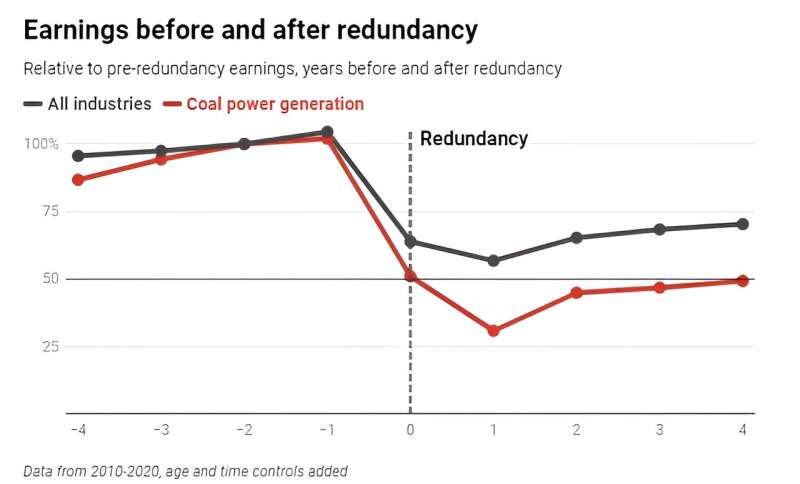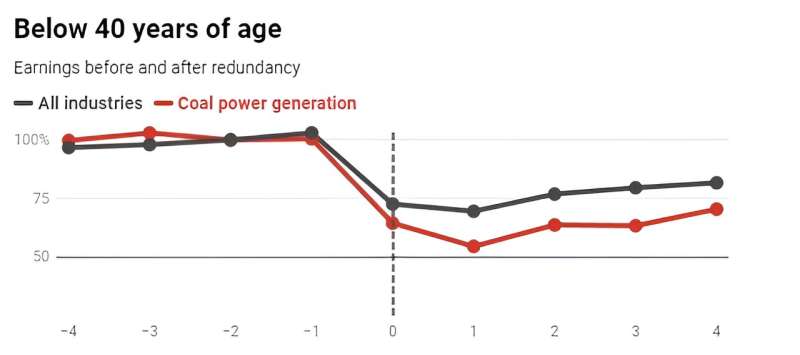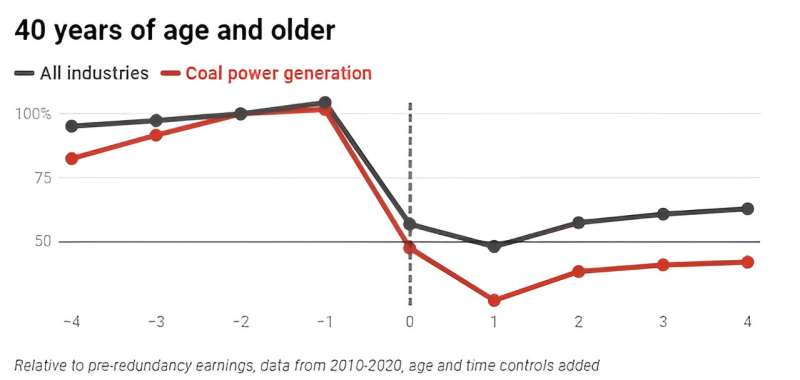This article has been reviewed according to Science X's editorial process and policies. Editors have highlighted the following attributes while ensuring the content's credibility:
fact-checked
trusted source
written by researcher(s)
proofread
Researchers: Here's what happens to workers when coal-fired power plants in Australia close. It isn't good

When Australia's dirtiest coal-fired power plant, Hazelwood in Victoria, closed in 2017, Australian authorities were blind to the collateral damage.
Closing a plant that accounted for a fair chunk of Australia's greenhouse gas emissions would help bring emissions down, but the costs to the displaced workers were unknowable.
How many of them would lose income, and for how long? How many of them would earn mere fractions of what they used to earn years into the future?
Twelve coal-fired plants closed between 2010 and 2020, and now a deep dive into the tax records of workers in that industry provides us with the first systematic insight into what happened.
The study we carried out for the e61 Institute along with colleague Lachlan Vass examined taxation microdata to track the earnings trajectories of Australians who received redundancy payments between 2010 and 2020 by industry.
Our study, published Oct. 22, finds that on average across all industries the workers made redundant earned around 43% less in the following year.
Incomes plummet by two-thirds
But workers made redundant in coal-fired power plants did much worse than the overall average. They earned 69% less in the year after they lost their jobs, earning a mere third of what they had.

Some of the loss would have been due to earning less in new jobs, and some of it would have been due to working fewer hours in new jobs. The tax data doesn't enable us to tell which is which. Both would be important.
And for workers who lost jobs in coal-fired power plants, the effects lingered.
Four years after being made redundant, the workers in coal-fired power plants earned 50% less. On average across all industries, the workers made redundant earned only 29% less.
Why power stations workers do badly
There are at least four reasons why the incomes of displaced coal-fired power station workers are likely to be lower than the incomes of other displaced workers.
One is that many coal-fired power plant workers possess highly job-specific skills (related to operating specialist equipment) that aren't readily transferable to other jobs, or at least not to other jobs in that location.
Another is that many coal-fired power plant workers derive high wages from strong union representation, meaning they are likely to earn less if they switch to less-unionized sectors.
Yet another is that coal-fired power plants are often a major source of local employment and provide support to other employers, meaning that when they close the overall unemployment rate in their region increases, making it hard for the workers they displace to get good jobs unless they move.

And another is that they are usually older. Bureau of Statistics data suggests that in 2010 55% of workers in coal-fired power plants were aged 45 or older compared to 35% in the economy at large.
Workers aged 40 and over do much worse after redundancies than younger workers, and workers in coal-fired power plants even more so.
The case for special support
Another 18 coal-fired power plants are set to close in coming decades. Our study suggests that while these closures will benefit the nation as a whole, helping fight the existential threat of global warming, they may impose foreseeable and long-lasting costs on an identifiable group of workers.
Half a century ago when Prime Minister Gough Whitlam slashed tariffs on imports by 25% in an effort to fight the lesser threat of double-digit inflation, he extended special support to those the decision would put out of work.
Whitlam offered every displaced worker retraining and "a weekly amount equal to his [sic] average wage in the previous six months until he obtains or is found suitable alternative employment".
Opponents of this sort of targeted support point out that the number of workers set to lose jobs from coal-fired plant closures is minuscule compared to the millions of workers who leave jobs for other reasons every year.
But there is something different about losing a job when it is the result of a government decision, especially one that targets a particular geographic region.
We now need a national conversation on whether special support is warranted for those we know the move to net zero will hurt.
Provided by The Conversation
This article is republished from The Conversation under a Creative Commons license. Read the original article.![]()





















